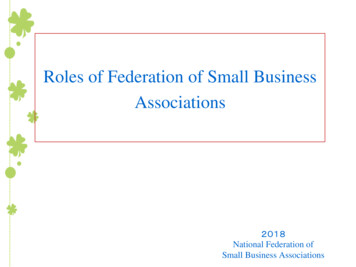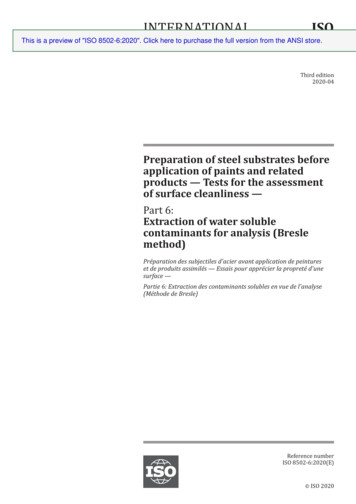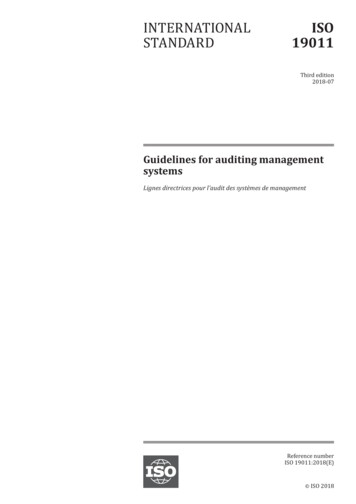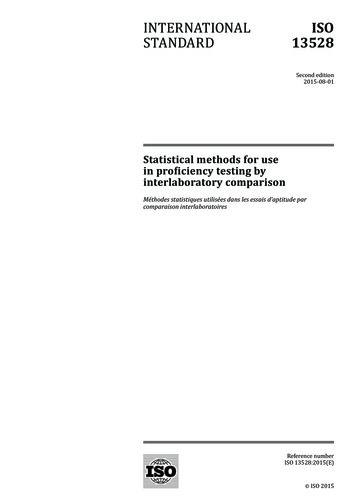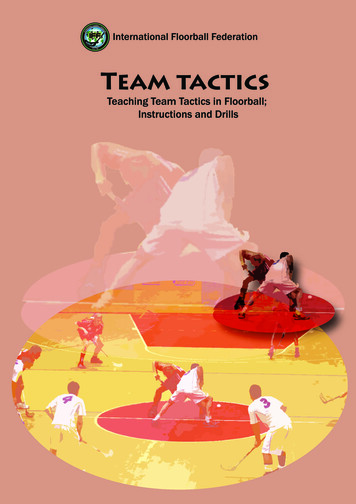
Transcription
TEAM TACTICSInternational Floorball FederationTable of ContentsIntroduction.5Tactical learning process.6What to emphasise in team tactics?.7Play book.7Terms and figures used.8Offensive play.9Openings (Offensive play in the defensive zone – lifting up the game). 9Level 1 .9Level 2.10Level 3.13Attacking (Offensive play in the offensive zone).19Level 1.19Level 2.21Level 3.23Transition (Counter attacks). 25Level 1.25Level 2.27Level 3.30Defensive play.32Fore Checking (Defensive play in the offensive zone) .32Level 1.32Level 2.34Level 3.37Defensive play on the defensive zone.43Level 1.43Level 2.43Level 3.44Transition from offence to defence.47Level 1.47Level 2.48Level 3.49Conclusion.51
TEAM TACTICSInternational Floorball FederationAcknowledgementsThe material for this manual is collected from the education material of the International Floorball Federation and itsmember associations. This manual is written in co-operation with some of the experts of Floorball in the world. I wouldlike to thank Mika Ahonen, Jari Oksanen, Juha Jäntti and John Liljelund from Finland, and Grant Mead and Jürg Khimfrom the Australian women’s national team for the consulting. I would also like to thank Merita Bruun for sharing opinions and encouragement.In Helsinki, the 20th of September, 2007Anniina Paavilainen, the author
TEAM TACTICSInternational Floorball FederationIntroductionTeam tactics is the team’s tactical playsystem that the team uses in orderto gain structure and discipline in itsplay, as well as provide safe ways toact in given situations for the players.Team tactics is the team’s tactical play system that the teamuses in order to gain order and discipline in its play, as wellas provide safe ways to act in given situations for the players.When five players are on the court at the same time, they shouldknow what to do in different situations, and with given tactics,it is easier to make them aware of team mate’s next actions.Team tactics are also important for the coach to bring outthe best in each player. By determining positions accordingto each player’s capacities, whether it’s physical or mental,is the best way of utilizing the recourses.Trends in FloorballIn floorball, the determined play positions are more orless passed in the history. Positions are changed and rotated all the time during the game, a defender can lift up theplay and end up scoring in the opponents slot which forcesone forward to stay and back the defender up. Thereforeyoung players should be taught to play all different positions.Every player should also at least once try as a goalkeeper.Some other characteristics in floorball today canbe seen in the team play system of the top leagues.A winning team bases its tactics on offensive play.There are practically two different ways to attack; organised attacks and transition (counter attacks).Some teams rely on holding the possession of the ballby slow and strictly organised attacks but the trend in thetop leagues is to base the offensive play on straight forwardattacks with short distances and one time passes using allfive players in a unified front. When the defensive teamis standing still in the fore checking figure, they are easilyoutplayed by speed and quick ball moving. This demandsa lot from the players, such as technical capacity to execute accurate one time passes and ability to read the game.Another offensive tactic is transition. Transition fromdefence to offence demands a lot of skill and reaction speed, but can be a weapon that the opponent hasno chance to beat, with no time to organize the defence. Counterattacks can only be beaten with quick returnfrom offence to defence which also should be practiced.In the defensive play the most used fore checking figures are 1-2-2 with a directing top player and mancover in the defensive zone, and the classical 2-1-2.Progression and the levelsThe aim of this material is not to give the optimal solutionto the question which team tactic is the best. The objectiveis neither to give an answer which system a team should usebut more or less help the coach to come up with the optimal system for the team and explaining the factors affectingthat decision. The coach should be aware of all the tacticalmatters and should be able to give objectives to create motivation even when the players question the chosen tactic.Different offensive and defensive system are handled at a basic level. Also exercises to practice these systems are included.The main emphasis on these exercises is on the individual skillsneeded in the specific system and on developing those skillsand the ability to make decisions in specific team tactical situations. The drills are planned to be as game like as possible.The exercises are divided in three levels according to the levelof the players. On the first level, the individual technical skillsneeded in the system are practiced. These drills are much likethe drills on the first part; Individual technique and tactics. Thesecond level provides exercises with individual tactical skillswhen more than one decision is to be made. The third levelconsist of game situations exercises with five players each side.The line between the levels is thin and the exercises might overlap, but the objective is to divide the progression according to the level of difficulty and development. The team should naturally practice the thingsneeded in the tactic, but it is up to the coach whether tostrengthen weaknesses or make strengths even stronger.
TEAM TACTICSInternational Floorball FederationTactical learning processTeaching tactical knowledge can be divided in three parts:Individual, in small units and team tactics. To gain themaximal results in each player, these parts should be introduced in this order.Team tactic is based on game understanding, discipline,trust and the coaches and players’ ability to read the game.All these skills can, and should be trained constantly duringpractice. Of course the players’ ability to comprehend andadopt tactical skills has a strong influence on the learning process as well. Coaches should always take into considerationthe level of the players’ mental and physical capacity and keepin mind that the learning process is different among players.With children, the coach should be more considerate towardsthe individual skill development and proceed in a certain order,when it comes to both individual and team tactics. This orderof the progression can also be used during eac h practice session.1. IndividualPlayers will adopt individual tactics at a young agewithout acknowledging it. They will automatically learn with lots of repetitions, how to behavein certain situation. They will learn to make thebest decision from all given options if they are justprovided with the right learning environment.Floorball, just like any other sport, is not just aboutindividual technical skills and team tactics. Theindividual ability to react fast with right decision ina given situation is extremely important and shouldbe at least in the background of each practice fromthe beginning of a young player’s career. Thereforethe individual tactics should be priority numberone in the beginning. If team tactics is emphasisedtoo much at an early stage, it might destroy a youngplayer’s creativity and technique. Tactical terms, suchas fore checking, angling, man cover, space cover,however should be used in order to make the termsfamiliar to the players. Also the rules and the natureof the game should be internalized at an early stage2. In small unitsWith slightly older players (13-15 years) or olderplayers just starting to play floorball, the tactics canbe introduced in smaller units, such as three againstthree games. At the same time the technical abilitiesare learned. Also the tactical terms should be clearfor the players before moving on to the next level.3. Team tacticsWith adolescence and adult players (16 years andup) team tactics should be emphasised during eachpractice. Technical and individual tactical skillsshould be at such level that they are not to be enforced anymore.
TEAM TACTICSInternational Floorball FederationWhat to emphasise inteam tactics?Play bookThe coach can and should make a use of a playbook. The play book should be used as a tool to givewritten instructions and ideas to the players andto give motivation and objective for the players topractice according to the chosen system. It shouldinclude topics such as: Slogans, tactics in offensiveand defensive system, certain individual responsibilities in each play position, team rules and perhapsthe practice schedule. Before planning a play book,certain topics should be considered, such as the material and the level of the players, the type of players,the size of the home rink etc. The play book shouldbe alive during the season according to different variables. The opponents play system and the changesin the line-ups can make a difference during theseason so the coach should always leave some roomfor the plans to change.When choosing the team play system, the coach shouldcarefully think what are the players’ strengths and weaknesses. It would not be wise to base the team tactics on quickpassing if the player’s technical skills are inadequate, or ifthe physical capacity of the player’s is below average, touse man to man defence against more physically superiorteam. The material is the most important thing to consider when choosing the tactics. The tactic should therefore be created for the players not vice versa. However if theaim is to constantly develop players and the tactical knowledge; all skills, even those not fully mastered should betrained during practice. This will create a basis for the playersto adopt other technical and tactical skills in the future.The external factors also have an effect when choosing the tactics. For example the size of the home rinkmight determine whether the team uses straightforwardattacks (narrow rink) or organized attacks (wide rink).When building up the team tactics, the players’ skillsshould be strictly evaluated. The offensive tactics should beconsidered so that the material used would be taken advantaged of. To win games demands scoring, and scoring is theresult of controlling the game as an offensive party. Therefore in a winning team, offensive play is always prioritised.In the defensive play it is best to teach one system at a timeor at least choose one system as a basic system for the team.Team tactics should also be there to make an individual playerfeel safe especially if the same tactic is used throughout theseason. In this case it should be clear to the players in whichposition they are in, and if practiced thoroughly, also the options in each situation should be provided and trained. In thecontinuation, when the players are skilled enough to adoptmany different play systems, the team is able to change thetactic between games and periods or even inside one period .
TEAM TACTICSInternational Floorball FederationTerms and figures usedMoving without ballPassingMoving with ballShooting Offensive player witha.ballOffensive playerWithout a.ballOpponent withouta.ballCone
TEAM TACTICSInternational Floorball FederationOffensive playSome might say that the defensive team play system is theonly thing that determines a team’s tactic. But as alreadymentioned in the previous paragraph, winning team bases its team play on offence. Things like the length of attacks, openings and ball movement can be practiced so thatthey become common and known for the players. The basic factors in offensive play are the openings, finishing attacks and counterattacks (quick transition from defence tooffence). Different variations should be practiced, so thatalso unpredictable situations are considered. If the playersare provided with options to change the system, for example in openings, the opponent is more easily outplayed.Openings (Offensive play in the defensive zone – lifting up the game)Level 1Drill 1Objective: To practice passing andreceiving standing stilland while movingModifications:Organisation: One player can beadded in the middle tomake the passing moredifficult If the player in themiddle cuts the pass,the one who passedwill go to the middleExecution:Key points: Players divided ingroups of six personsforming a “diamond” One ball each group Players start passingthe ball around firstjust standing still (onetimers) After a while they willstart moving by following one’s own pass Passing one timers The players should bein constant movement Head up Passing to the forehand sideThe individual technique of each player is one of the mostimportant factors in all offensive play including openings.The basic individual technical skills required in the openings, using both defender-defender and libero play are passing and receiving, standing still and in movement. Theseskills are usually practiced during warm-up drills but canand should also be emphasised when practicing tactical topics. The importance of accurate passes and especially skilful receiving should not be neglected. Both one time passes using short forehand passes and longer distance passesusing forehand pass with follow through should be practiced. Both can easily be done in pairs. Soft hands can beemphasised in aerial passes which are more difficult to receive. With short forehand passes the short distance of theplayers should also correlate with the forced used in passing.When using defender-defender in the openings the distance of the two lowest players is usually longer and in liberoplay the distance is shorter. Therefore suitable passing techniques should be practised according to the tactic used. Theplayers should be encouraged to pass and receive a pass whilemoving and always to an open space instead of a player standing still. If the player is standing still, the opponent is morelikely to read the passing direction and cut the passing lane.Also maintaining possession of the ball is important inthe offensive play as the opponent might direct the ballcarrier into the corner or by the rink if there is no quickchance to open up the play. Protecting the ball becomes important when the ball carrier is covered by the opponent.The players without the ball have to keep moving aroundthe court in order to create passing lanes for the ball carrier.Drills with lots of movement and speed need to be practiced.Drills to practice technical skills can also be foundin the material; Individual Technique and Tactics.Moviv ng without ballPassingMoviv ng with ballOffef nsive player witha ballOpponent withouta ballShootingOffef nsive playerWithout a ballCone
TEAM TACTICSInternational Floorball FederationLevel 2Drill 2Objective:Modifications:Organisation:Key points: To practice passing andreceiving while moving To practice movingthrough the wholecourt as in an opening Players form a linebehind the goal One player in the corner, one player in thecentre and one playerby the rink in the otherendExecution: A1 passes the ball to A2in the corner A2 takes control of theball and continues themovement along therink A2 passes to A3 whopasses a one timerback A2 passes to A4 whois positioned by therink at the other endand continues themovement towards themiddle and the goalwith a slight angle A2 receives a pass fromA4 in front of the goaland shoots A1 becomes A2, A2becomes A4 and A4becomes A3 The positions of A3 andA4 can vary accordingto the coaches choices A3 and A4 can also bereplaced by coaches Head up Game like posture andmovement of the ballcarrier The situation simulates an opening and itshould be emphasisedto the players When receiving thefirst pass the player(A2) should be in sideway movement keepinghead up and searchingfor a passing possibility The movement shouldbe constant whenpassing and receivinga pass The executing playershould head towardsthe goal with a slightangle to the middle toget a better scoringposition (pass comingfrom the side, not frombehind)On the second level, the terms and concepts are goodto go through with the team. With a younger team it isenough if the players are aware of the terminology the coach is using. The individual tactics should be emphasised, sothat each player knows the responsibilities in each position.The drills and objectives should be kept as simple as possible so that the player’s ability to transform the knowledgeinto game like situations remains. With more experiencedplayers the terms are known, so the coach should emphasisethe main points, like the aim of the openings or the movement of each individual player. Also the options a player hascan be varied so decision making becomes more relevant.Opening the game is the first thing a team has to consider after gaining the ball from the opponent, whether after interception or stealing the ball. The way a team decidesto open the game depends on many other factors, such asthe chosen tactic, the opponent, and the situation in hand.The level of the players plays a big part when determiningthe opening style. The decision making of the ball carrierdetermines the actions of the non ball carriers; whether topass forward or backward, or maintain the possession of theball. When choosing to pass, the player should always support the pass in case the receiver of the pass is unable tocontrol the ball or the pass is intercepted by the opponent.Individual skills needed in openings: Readiness to pass and receiveMovement Supporting one’s own pass Reaction speed Decision making (whether to make fast counterattack or an organised attack)A1A2A3A410 Moviv ng without ballPassingMoviv ng with ballOffef nsive player witha ballOpponent withouta ballShootingOffef nsive playerWithout a ballCone
TEAM TACTICSInternational Floorball FederationDrill 3Objective:Drill 4Objective: To practice passingpast an opponent To practice difficultpasses T o practice the movement in the openings To practice readinessto pass and receive apass while moving To practice gaining ascoring chanceOrganisation: Players form groups ofthree players with oneball each groupOrganisation: P layers form a line inthe corner (A1) One player in the middle area by the middleline (A2) One player in the opposite corner (A3) Executed in both sidesof the courtExecution: Two players in five toseven meters distancepassing to each otheras in defender-defender opening The third player as atop striker trying to cutthe passing lane The players with theball are trying to execute successful passeswith the top strikerharassing the players If the top striker succeeds on interceptingthe pass, the playerswill switchExecution: A 1 starts from thecorner with the ballpassing to A2 A2 will take controlof the ball and movestowards the rink A1 follows the passcrossing with A2 fromthe middle A1 receives a drop passfrom A2 A1 continues with theball and passes to A3who has moved towards the middle line A3 gives a one timepass to A1 who shoots A1 becomes A3, A3becomes A2 and A2becomes A1Modifications: T he players with theball can make it evenmore game like bytrying to maintain asideways position The coach can determine how close the topstriker goes towardsthe one with the ballwhich will describethe level of the forechecking and makes itmore difficult for theball carrierKey points:Modifications: C an start with shorterdistances A2 can be stationary inthe beginning and A1run along the rink topass and receive a passfrom A2 before themiddle lineKey points: G ame likeness shouldbe emphasised Players should be constantly moving and theblade should almosttouch the floor all thetime for the readinessto receive a pass A2 should make a clearmove towards the rinkand pass from protection (in a game situationthe player is mostlikely to be covered byan opponent which alsocan be included andplayed by the coach) A3 should come towards A1 to receive apass and not stand inthe corner A3 can also start themovement from theslot and empty the space for a shot by movingtowards the rinkA1 P layers should use allkind of passes, alsobackhand and aerial Players should beencouraged to passeven in tight situationsand not to back up orturn their back to theopponent Players should avoidusing one time passesin order to maintainthe objective of theexerciseA2A3Moviv ng without ballPassingMoviv ng with ballOffef nsive player witha ballOpponent withouta ballShootingOffef nsive playerWithout a ballCone 11
TEAM TACTICSInternational Floorball FederationDrill 5Objective: To practice the movement of the forwardsduring openings For the ball carrierto practice decisionmakingOrganisation: One player in themiddle on the defensive zone as a centreforward (A2) One player on the middle line by the rink as awing forward (A3) One player in themiddle on the offensive zone as a topstriker(A4) One player behinddefensive zone’s goalas a defender (A1) withrest of the players andballsExecution: A1 starts moving sideways with the ball frombehind the goal At the same time A2will move towards therink A1 passes to A2 Simultaneously withA2’s movement A3empties the side by therink by moving up andtowards the centre A2 takes possessionof the ball and passesto A3 A3 has to make a decision depending on themovement of A4 A4 can either: rush to the slot toscreen the goalkeeper(option 1)- A3 shootsor empty the centre areaby moving towards therink (option 2) - A3passes to A4, whereafter A4 can pass a onetimer to A3 or shoothim/herself After the executionA1 becomes A2, A2 becomes A3, A3 becomesA4 and A4 becomes thelast one in line12 Modifications: The coach can come upwith different variations Also the goalkeepercan be used in thestart of the opening bythrowing the first pass The coach can harassA3 and therefore forcehim/her to make adecisionKey points: The timing of movement should match thepasses Game like posture andmovement A3 should keep headup and pay attentionto the action of A4 tomake a decision A3 can also shootwithout A4 screeningthe goalkeeper, but itis more useful to havesomeone in front of thegoal if there is a shotfrom a long distance The movement of thehighest player is crucial in the game evenwhen the ball is still onthe defensive zone tolure the opponent andempty space for theball carrier or a shotA1A2A3A4Option.2Moviv ng without ballPassingMoviv ng with ballOffef nsive player witha ballOpponent withouta ballShootingOffef nsive playerWithout a ballConeOption.1
TEAM TACTICSInternational Floorball FederationLevel 3Organized attacksTo give hard tactical instructions usually works better foryounger players and beginners but with more experiencedand older players, creativity and ability to read the gameplays a more important role in the offensive play. First thecoach should plan and instruct the opening system so thatall players are aware of their positions, the movement of theball and other players. Thereafter the players should be awareof the aim of the attack which can be for example:Organized attacks are used after an interception when theteam is about to switch lines or the team has no chance tocounter-attack. Therefore the player, who intercepted the ballfrom the opponent, decides to pass the ball back to the defensive zone in order to calm down the play. Also free-hitsand hit-in’s from the defensive zone are starting points fororganized attacks. Organised attacks give the forwards anoption to create passing lanes and chances to shoot in the offensive zone. The negative point is that it also gives a chancefor the opponent to organize their defence. Organised attacksworks best if the passing lanes and figures are well practicedwithin the team.Two different tactics are used in the openings, but also variations of these are possible:1. Safe lifts up by the sides, where the whole teamis giving pressure on the offensive zone.2. Lifting the ball up towards the opponents slotto make fast finish of the attack by directing theshot or hitting in possible rebounds. This mightbe appropriate during the last minutes of thegame while trying to even the score.3. High lifts towards the offensive corners to thetop striker to fight for when the team is playingshorthanded or when the team is winning anddoes not want to loose players in the offensivezone (defensive play).4. Fast and direct attacks after interception inorder to create open space for counterattacks.These decisions are made according to the opponent andgame situation. When these aims are made clear to theplayers, it is much easier to create passing lanes and empty space for the attacks. After defining the aim, the coachshould choose few simple figures to open up the passing lanes. The exercises should be made so that a game like situation is created all the way from the opening to the finish. Thesepatterns should then be practiced so that the players knowthem without having to be shown every time. Also differentvariations should be practiced, especially after the players areable to read the situation.There are three different ways to open up the game; organized attacks, improvisation, and counter attacks (see transition).1. Libero play When team is using one player in the bottomand two players on the sides as wings Rotation and drop passes Two forwards up in the offensive zone to createpassing lanes One of the forwards might create a passing lanein the middle depending on the fore checkingfigure of the opponent The movement of all five players is extremelyimportant to lure the opponent and open upspaceLIBERO.PLAYMoviv ng without ballPassingMoviv ng with ballOffef nsive player witha ballOpponent withouta ballShootingOffef nsive playerWithout a ballCone 13
TEAM TACTICSInternational Floorball Federation2. Defender-defender When team is using two defenders to open upthe play This is perhaps a more offensive way to open upthe play as there are three players in the offensivezone Also the risk of a 3 against 2 attack for the opponent is bigger The distances should be kept short between theball- and non ball carriers The attackers should always be moving Can easily be transferred to back triangle with alibero player If the defender, or any other player for that matter is about to shoot from distance, there shouldalways be one player in the slot to screen thegoalkeeper and shoot in possible rebounds (whenfinishing attacks)play. In organized attacks, players must be aware of the position they need to be in for each situation. They should havethe ability to react and adjust if necessary according to theopposing team’s movements and positioning. The openingsmight not always work out as planned but with repetitionand constant formation, the players should be aware of different options to adjust the play with. Different ways shouldbe practiced with line-ups using the whole court.The drills are up to the coach to plan according to the chosen way to open the game. Some examples are inclu
TEAM TACTICS International Floorball Federation Tactical learning process Teaching tactical knowledge can be divided in three parts: Individual, in small units and team tactics. To gain the maximal results in each player, these parts should be intro-duced in this order. Individual Players will
